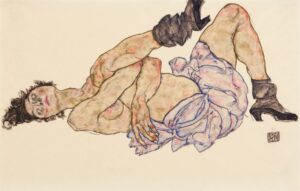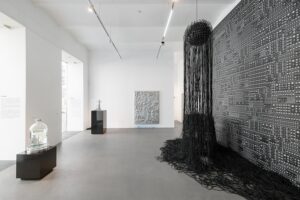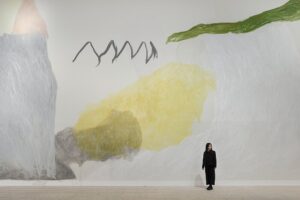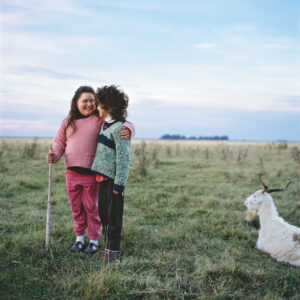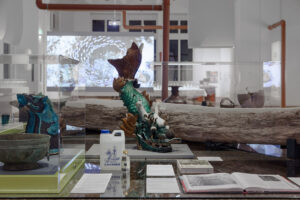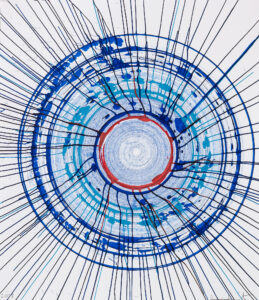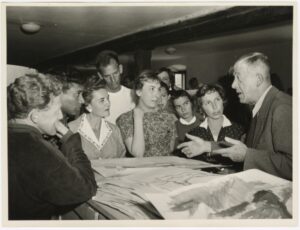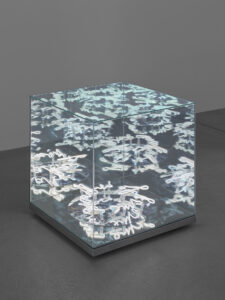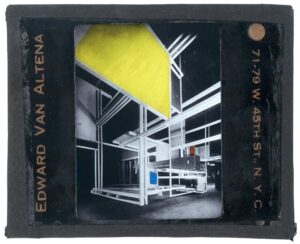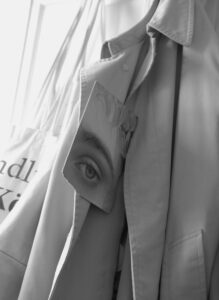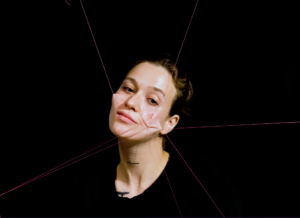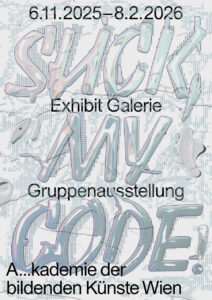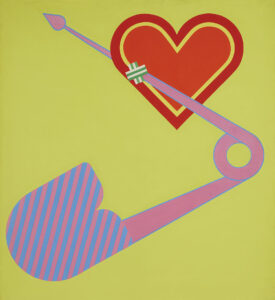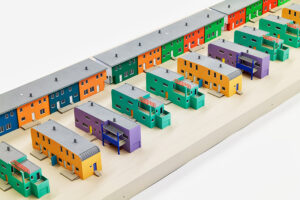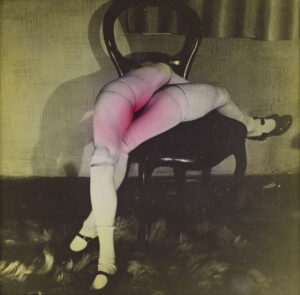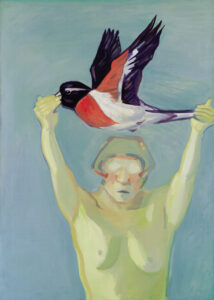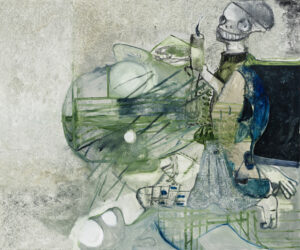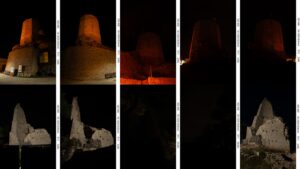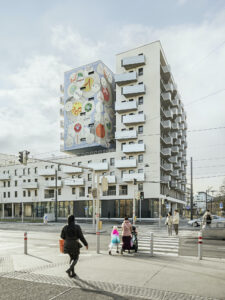Nicholas Grafia in conversation with Francesca Altamura
Francesca Altamura (FA): Your upcoming solo presentation at KOENIG2 by_robbygreif in Vienna is titled “Soul Burner,” and will be on view from March 26–May 22, 2021. Whose soul are you burning in this exhibition?
Nicholas Grafia (NG): Hopefully everyone’s! [laughs]. To be honest, the title sets the meditative tone for the exhibition, and alludes to those “burning questions,” as well a certain kind of restlessness in the soul, that is, both, involuntarily experienced by some and willfully inflicted by others who played a role in the show’s formation and conceptual framework.
The works in the exhibition were first presented in 2019, as part of my graduation installation at the Kunstakademie Düsseldorf (DE), which consisted of two paintings and a video documentation of the core performance, It’s 10PM. Do You Know Where Your Children Are? (2019), previously showcased at Dortmunder Kunstverein (DE) and conceived alongside my artistic collaborator Mikołaj Sobczak from Poland. In addition to that, the paintings served, both, as storyboards and scenography to a series of performances enacted within my installation throughout graduation week, each lasting between thirty to forty minutes. The performances were mainly reflective of post-colonial trauma, the experience of slavery, global folklore and mythological archetypes.
FA: It’s 2021. We’re living in an extremely different world than we were back in 2019, when this series of paintings and performances were made. How have you been able to reflect on the ideas and themes that were originally imbued into those works?
NG: It feels to me that what was very politically urgent back then is of even more immediate concern here and now, especially in how power dynamics have been exacerbated by gross economic disparities. During the global Covid-19 pandemic, such dichotomies and differences in hierarchies became even more apparent. Many groups and individuals are still being pushed further towards the margins of society, due to varying privileges. The world is still very uneven.
FA: In Babaylan Baller (2019), you paint former American professional basketball player Dennis Rodman. He’s a problematic character, mainly because of his politics, however, he’s also a very complex public figure. What inspired you to depict him as a protagonist in your painting?
NG: He was often perceived as very subversive in his actions. One reason was because he dressed in drag while playing basketball. I think there are issues he’s “reaffirming” by doing that, because he’s also a hyper-masculine icon. Reading him as “subversive,” or queer, might be problematic in itself. In Babaylan Baller, I painted him in a very different context, transporting him into a scene from the colonial times in the Philippines. I wanted to build a certain connection, in order to open up a projection space for in-depth confrontation, constructive irritation or questioning. Associating Rodman with a Filipino Babaylan, which is a queer shaman who specialized in communicating, appeasing, or harnessing the spirits of the dead and the spirits of nature in pre-colonial times, mimicked the ways in which they both had sway in society at-large and on various cultural levels.
FA: Negotiating the problematic aspects of certain pop cultural icons seems to be key to your practice. I had a friend recently tell me that they don’t like to “be perceived.” What do you think about this as contemporary praxis?
NG: That is a compelling statement as it seems to elicit subsequent questions for me, like, if you don’t want to be perceived, then what do you want? What is the other option? There seems to be some sort of one-way channel as to how you’re trafficked into the world. What I find really striking here is how much people desire agency to be independent from judgment. They don’t want to be put into a box out of which they can never escape. I can definitely relate to that statement; looking back at my personal histories, my biography, and the way I have been, for example, racially profiled. Profiling, in various ways, often plays a role in the world at large, and it really has the ability to harm your mobility in society and chances in life.
FA: However, as a painter, you are able to exert complete control over the canvas.
NG: That’s very true. The way I construct my paintings actually has a lot to do with preliminary drawings. I’m a huge fan of comic books and visual storytelling. When I was reading those as a younger person, they opened up new worlds to me. I really want to irritate any straightforward reading of my works. This is why I love to create very unresolved compositions, with atypical color schemes, too. Most of my figures are like shape-shifters, such as Mystique from the X-Men comics, who is one of my favorite characters. Being a shape-shifter also means adaptability and flexibility. I feel like this trait is one that marginalized subjects often inhabit. Being able to adapt is a means of survival, especially in certain hostile and alienating conditions, due to patriarchy, white supremacy, and late-capitalism.
FA: To your point, there’s a long history of resilience in using strategies like that to survive. How do these methods influence your sketching or script-writing processes?
NG: When I make decisions about what to perform, it really has to do with certain narratives I feel compelled to construct. I am always envisioning the performative aspects that may come to light after a painting is completed, and vice versa. Everything I do, independent from medium and genre, becomes a gateway into another dimension. Threading together different narratives, presentation modes, and time periods in a “rhizomatic” way helps me identify and make conclusions on the social developments in my immediate and lived surroundings.
FA: That makes sense considering there’s such fluidity throughout your practice. In your works, there’s also a clear connection to folklore and mythology. How do you seamlessly integrate these stories?
NG: As of late, artists have been engaging more with their upbringings, cultural roots and inherited privileges. I see incredible potential in these reflections that help elucidate and combat social processes of othering, alienation, and marginalization. Various elements of folklore, from my Filipino roots, have become fascinating to me throughout the years, as has Slavic mythology, which Sobczak has taught me a lot about. This cross-pollination has allowed us to identify certain archetypes throughout our cultures. In our joint explorations, we hope to trace certain factors that have led to modern civilization’s creation of these mythological archetypes.
When I was conceptualizing the series back in 2019, I was reading the travel log of Fray Juan de Plasencia, a Franciscan missionary from Spain, who lived during the country’s so-called Siglo de Oro, or Golden Age. In his written account “Las Costumbres de los Indios Tagalos de Filipinas (Costums of the Tagalogs)” (1589), the missionary provided a typically colonialist, yet on many levels, insightful depiction of Filipino Indios’ quotidian life, social rituals, and spiritual beliefs. In particular, he was describing manifestations of the devil and his imps, some of which were basically vague reinterpretations of the shaman and the witch, which have a lot to do with patriarchy. The previously mentioned Babaylan figure, played an important role in that European account, who was mostly portrayed as a sinful being with ambivalent gender presentation. In a nutshell, this goes to show how Christianity, brought to the Philippines by the Spaniards, worked to destabilize already established customs in Filipino society, leading to the exclusion of previously respected authority figures, such as the “two-spirited” shaman character of the Babaylan.
FA: The control Western societies have imposed over countries like the Philippines resembles a real stranglehold on many levels. In a way, I see similar lineages being constructed in your painting, Tummy Top Hitting Rock Bottom (2019), also on view.
NG: That’s correct. This painting was inspired by another narrative that derived from Filipino colonial history, which demonstrates an example of how governing bodies often rely on terror and propaganda to strategically maintain their authority. Spanish colonizers kept Filipino Indios scared and psychologically trapped in so-called Encomiendas, or labor camps. What I found so perfidious was how the Spanish colonizers used Filipino superstition to their advantage in controlling the enslaved community. The Spaniards infiltrated their belief systems by spreading rumors about sightings of a new type of monstrous being, or Aswang, that already existed in their culture. The Spanish’s Aswang were fabricated to be seen as evil shape-shifting creatures that happened to hunt right outside the Encomiendas. The Spaniards even went so far as to blame the murder and mutilation of Indios on the evil Aswang. Intimidated by those incidents, many Indios succumbed to the propaganda and misinformation campaigns emboldened by the colonizers, and, as a result, did not dare to leave the labor camps, even when they were supposedly able to leave on their own accord. However, it is important to note that there are so many inconsistencies throughout this historical retelling, and it’s not even clear to me how some Indios ended up in the camp while others didn’t. A majority of the accounts from that period were written from the dominant colonialist perspective. I became particularly interested in the transmission of these oral stories as there is a lot of space for speculation and renegotiation. I am curious to see where historical gaps exist, when they occurred, and most importantly, why many of them prevail throughout history and into the contemporary.
FA: We worked together on the digital exhibition “I don’t know whether the Earth is spinning or not…” for the VII Moscow International Biennial for Young Art (on view at www.notspinning.world), and I can say that it has been a pleasure to collaborate with you. How important is sustained artistic exchange between other artists, performers, and curators you work with now and in future?
NG: I enjoy working with the same person repeatedly, but then also, all of a sudden, bringing in someone new into a triangular constellation. I love growing with people in a specific way that creates a safe zone, so it’s not like one-way traffic, or starting from zero. I also like getting to the point of particular dialogues and discussions, especially when it’s easier to inch closer to the ends of someone’s boundaries.
I am excited to transgress certain things together. Lots of worlds colliding together make for a richer experience of life and culture. Multidisciplinary collaborations and ongoing artistic dialogues have therefore always been ways to familiarize and immerse myself and others with various perspectives and contexts. Oftentimes, I find that very inspiring and helpful in trying to make sense of society at-large.
Nicholas Grafia (DE, *1990, Angeles City, Philippines) is an artist living in Düsseldorf. He holds an MFA from the Kunstakademie Düsseldorf (DE). He has previously studied at the Kunstakademie Münster (DE), the School of Arts and Cultures in Newcastle (UK) as well as British, American and Postcolonial Studies at the University of
Münster (DE). His paintings, videos and performances, frequently made in collaboration with Polish artist Mikołaj Sobczak, negotiate processes of memory formation, as well as the in- and exclusion of subjects from history
writing.
His works were recently exhibited at Peres Projects (Berlin, DE), VII Moscow International Biennale for Young Art (Moscow, RU), Capitain Petzel
(Berlin, DE), Shoot the Lobster (New York, US), signs and symbols (New York, US), Kunsthal Aarhus (Aarhus, DK), Andersen’s Contemporary (Copenhagen, DK), Museum Ludwig (Cologne, DE), K21 Museum Düsseldorf (Düsseldorf, DE),
fffriedrich (Frankfurt am Main, DE), Tramway (Glasgow, UK),
Kunstraum (London, UK), Kunstverein für die Rheinlande und Westfalen Düsseldorf (Düsseldorf, DE), Dortmunder Kunstverein (Dortmund, DE), Exo Exo at David Giroire (Paris, FR), Museum of Modern Art (Warsaw, PL)
and BOZAR (Brussels, BE).
Francesca Altamura is a curator and organizer living in New York (unceded Canarsie/Lenape lands). She recently curated „I don’t know whether the Earth is spinning or not…“, with Lizaveta Matveeva, for the VII Moscow International Biennale for Young Art. The digital exhibition is on view at notspinning.world. In 2021, they will curate a group exhibition together at Haus N, Athens, Greece. In 2019, she co-curated “Diedrick Brackens: darling divined” with Margot Norton, for the New Museum in New York, which travelled to the Blanton Museum of Art, Texas, in 2021. At the New Museum, she also curated presentations by Randa Maroufi (2020), Sydney Shen (2019), and Ahaad Alamoudi (2019), and has assisted on exhibitions by artists including Peter Saul, Daiga Grantina, Hans Haacke, Lubaina Himid, Marta Minujín, Nari Ward, Sarah Lucas, Thomas Bayrle, and John Akomfrah. She has curated exhibitions independently at The Carillon Gallery, Tarrant Community College South Campus, Fort Worth, Texas (2019), LADRÓNgalería, México City, México (2017), and The Government Art Collection, London, UK (2016). She has also contributed to the group exhibitions “The Warmth of Other Suns: Stories of Global Displacement” (Phillips Collection, Washington DC), “The Same River Twice: Contemporary Art in Athens” (Benaki Museum, Athens), “Strange Days: Memories of the Future” (The Store X, London), and the 2018 New Museum Triennial: “Songs for Sabotage.” She proudly served as Delegate for the New Museum Union—UAW Local 2110, which formed in January 2019. Altamura holds an MFA in Curating from Goldsmiths, University of London. itmefrankie.online
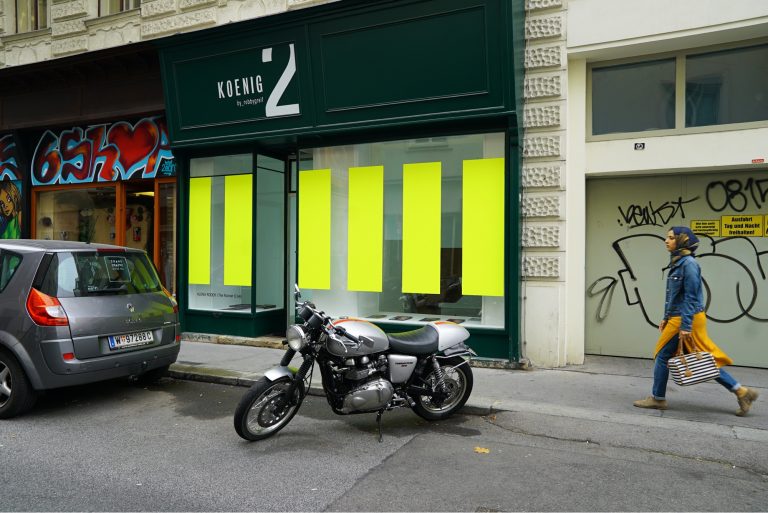
Margaretenstraße 5, 1040 Wien
KOENIG2 by_robbygreif
Christine König Galerie wurde 1989 in Wien gegründet. Die Galerie repräsentiert eine Vielzahl internationaler, etablierter Künstler und arbeitet gleichzeitig mit einer dezidiert jüngeren, aufstrebenden Generation. Das Programm der Galerie und die Auswahl der Künstler orientiert sich stark an Themen, die für Christine König relevant sind: Politik und Aktivismus, Feminismus, Literatur, aber auch postkonzeptuelle Ansätze. Kunst ist in den letzten Jahrzehnten zum dominanten kulturellen Handlungs- und Diskursfeld geworden. Mehr als über Popmusik, Literatur oder Film kann über bildende Kunst Verständnis für und Einsicht in gesellschaftspolitische und kulturelle Veränderungsprozesse gewonnen werden.
KOENIG2 by_robbygreif ist seit 2017 der neue Projektraum – fokussiert auf junge und experimentelle Positionen, die das Programm der nahe gelegenen Galerie ergänzen. Die Ausstellungen in KOENIG2 sind nur nach Vereinbarung geöffnet, aber 24 Stunden beleuchtet und von außen einsehbar.
Nicholas Grafia | Soul Burner
26 Mar 2021 - 22 May 2021
NICHOLAS GRAFIA Installationsansicht Soul Burner, Kunstakademie Düsseldorf, 2019
